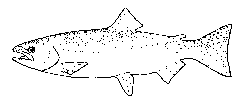

by Jim Hight 
Northern spotted owl, move over. You may soon be replaced as the most controversial critter in the Pacific Northwest.
On April 25, the National Marine Fisheries Service must decide whether to declare coho salmon in Northern California and Oregon "threatened" under the Endangered Species Act.
Timber companies with coastal lands that provide coho habitat may face restrictions far more extreme and widespread than those prompted by the owl or marbled murrelet listings.
The coho club has been hanging over their heads for nearly four years, since NMFS was ordered by a court to begin its "status review" of coho populations. The threat of the listing prompted much more attention in the industry to fixing the old roads and stream crossings that erode salmon-killing silt into watercourses.
With lots of cooperative restoration underway, the industry contends that federal oversight is not needed. Last year, as an earlier deadline in the listing process approached, the California Forestry Association and Gov. Pete Wilson led an intense political effort to delay the listing. Populations of coho were greater than previously believed, they contended, and the timber companies' long-term conservation plans would provide even more protection.
They got part of what they wanted. NMFS listed coho as threatened south of Punta Gorda (King Range) and delayed action on the northern areas for six months.
Coho-protection measures in the Central California area have yet to be defined. At least 12 timber harvest plans in Mendocino County and elsewhere are being held up as state forestry officials await federal review and direction.
One of the key issues is how close loggers can work to coho streams. Coho-protection measures might include large "no-cut" buffers along streams and other new forest practice rules that would significantly reduce the timber harvest yield in many watersheds.
But proponents of federal protection for the coho strongly believe that protecting and restoring this once-abundant migrating fish is worth the economic costs.
"If these fish are listed as threatened, there will definitely be a lot of economic consequences, but it will hold our feet to the fire," said Humboldt State University Fisheries Professor Terry Roelofs.
Roelofs acknowledged that timber companies have significantly increased their habitat restoration efforts. "But coho haven't disappeared quickly, it's been a trend over decades. To reverse that, we're going to be looking at that same kind of time scale. Their habitat doesn't heal that rapidly even if we do things a lot better."
Aside from the Northcoast Environmental Center, Sierra Club and other environmental groups, the most vocal advocates of ESA protection for coho are the commercial fishermen who used to troll for the fish.
Commercial ocean fishing of coho has been banned for more than four years, contributing to loss of employment and income for salmon trollers. And even though an ESA listing for coho could further restrict the larger chinook fishery (because of concerns over incidental hooking of coho), fishing groups are behind the listing.
"For the fishing industry coho salmon have been a de facto listed species ... for the past four years," said Zeke Grader, director of the Pacific Coast Federation of Fishermen's Associations. "It's about time the fish were officially listed so that those responsible for the near destruction of silver (coho) salmon and their habitat are held responsible."
Comments? E-mail the Journal: [email protected]
The North Coast Journal Table of Contents
The Redwood Country On-Line Homepage